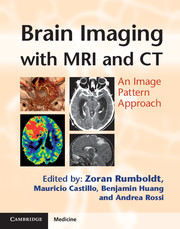Book contents
- Frontmatter
- Contents
- List of contributors
- List of abbreviations
- Preface
- Section 1 Bilateral Predominantly Symmetric Abnormalities
- 1 Hepatic Encephalopathy
- 2 Neurofibromatosis Type 1 – UBOs
- 3 Carbon Monoxide Intoxication
- 4 Pantothenate Kinase-Associated Neurodegeneration (Hallervorden–Spatz Syndrome)
- 5 Methanol Intoxication
- 6 Wilson Disease 12
- 7 Hypoxic Ischemic Encephalopathy in Term Neonates
- 8 Cryptococcosis
- 9 Gangliosidosis GM2
- 10 Leigh Disease
- 11 Deep Cerebral Vein Thrombosis (DCVT)
- 12 Creutzfeldt-Jakob Disease (CJD)
- 13 Global Cerebral Anoxia in Mature Brain
- 14 Wernicke Encephalopathy
- 15 Amyotrophic Lateral Sclerosis
- 16 Glutaric Aciduria Type 1
- 17 Subcortical Band Heterotopia
- 18 Bilateral Perisylvian Polymicrogyria (BPP)
- 19 Lissencephaly
- 20 Herpes Simplex Encephalitis
- 21 Limbic Encephalitis
- 22 CADASIL (Cerebral Autosomal Dominant Arteriopathy with Subcortical Infarcts and Leukoencephalopathy)
- 23 Megalencephalic Leukoencephalopathy with Subcortical Cysts
- 24 Canavan Disease
- 25 HIV Encephalopathy
- 26 Radiation- and Chemotherapy-Induced Leukoencephalopathy
- 27 Leukoaraiosis (Microangiopathy)
- 28 Periventricular Edema in Acute Hydrocephalus
- 29 Hypoglycemia
- 30 X-Linked Adrenoleukodystrophy (X-ALD)
- 31 Periventricular Leukomalacia (PVL)
- 32 Posterior Reversible Encephalopathy Syndrome (PRES, Hypertensive Encephalopathy)
- 33 Alexander Disease
- 34 Metachromatic Leukodystrophy
- 35 Neurodegenerative Langerhans Cell Histiocytosis (ND-LCH)
- 36 Remote Cerebellar Hemorrhage
- 37 Spontaneous Intracranial Hypotension
- Section 2 Sellar, Perisellar and Midline Lesions
- Section 3 Parenchymal Defects or Abnormal Volume
- Section 4 Abnormalities Without Significant Mass Effect
- Section 5 Primarily Extra-Axial Focal Space-Occupying Lesions
- Section 6 Primarily Intra-Axial Masses
- Section 7 Intracranial Calcifications
- Index
- References
25 - HIV Encephalopathy
from Section 1 - Bilateral Predominantly Symmetric Abnormalities
Published online by Cambridge University Press: 05 August 2013
- Frontmatter
- Contents
- List of contributors
- List of abbreviations
- Preface
- Section 1 Bilateral Predominantly Symmetric Abnormalities
- 1 Hepatic Encephalopathy
- 2 Neurofibromatosis Type 1 – UBOs
- 3 Carbon Monoxide Intoxication
- 4 Pantothenate Kinase-Associated Neurodegeneration (Hallervorden–Spatz Syndrome)
- 5 Methanol Intoxication
- 6 Wilson Disease 12
- 7 Hypoxic Ischemic Encephalopathy in Term Neonates
- 8 Cryptococcosis
- 9 Gangliosidosis GM2
- 10 Leigh Disease
- 11 Deep Cerebral Vein Thrombosis (DCVT)
- 12 Creutzfeldt-Jakob Disease (CJD)
- 13 Global Cerebral Anoxia in Mature Brain
- 14 Wernicke Encephalopathy
- 15 Amyotrophic Lateral Sclerosis
- 16 Glutaric Aciduria Type 1
- 17 Subcortical Band Heterotopia
- 18 Bilateral Perisylvian Polymicrogyria (BPP)
- 19 Lissencephaly
- 20 Herpes Simplex Encephalitis
- 21 Limbic Encephalitis
- 22 CADASIL (Cerebral Autosomal Dominant Arteriopathy with Subcortical Infarcts and Leukoencephalopathy)
- 23 Megalencephalic Leukoencephalopathy with Subcortical Cysts
- 24 Canavan Disease
- 25 HIV Encephalopathy
- 26 Radiation- and Chemotherapy-Induced Leukoencephalopathy
- 27 Leukoaraiosis (Microangiopathy)
- 28 Periventricular Edema in Acute Hydrocephalus
- 29 Hypoglycemia
- 30 X-Linked Adrenoleukodystrophy (X-ALD)
- 31 Periventricular Leukomalacia (PVL)
- 32 Posterior Reversible Encephalopathy Syndrome (PRES, Hypertensive Encephalopathy)
- 33 Alexander Disease
- 34 Metachromatic Leukodystrophy
- 35 Neurodegenerative Langerhans Cell Histiocytosis (ND-LCH)
- 36 Remote Cerebellar Hemorrhage
- 37 Spontaneous Intracranial Hypotension
- Section 2 Sellar, Perisellar and Midline Lesions
- Section 3 Parenchymal Defects or Abnormal Volume
- Section 4 Abnormalities Without Significant Mass Effect
- Section 5 Primarily Extra-Axial Focal Space-Occupying Lesions
- Section 6 Primarily Intra-Axial Masses
- Section 7 Intracranial Calcifications
- Index
- References
Summary
Specific Imaging Findings
The most common finding in HIV encephalopathy is diffuse brain atrophy, which is progressive and more prominent in the patients with dementia. White matter lesions which are better seen on MRI are the second most common finding. They are characteristically diffuse; however, patchy, focal or punctate lesions may also be seen. They are of low attenuation on CT and T2 hyperintense, while isointense to minimally hypointense and therefore inconspicuous on T1-weighted images. The abnormalities show increased diffusion and typically spare the subcortical U-fibers. Contrast enhancement and mass effect are absent and the overlying gray matter may appear atrophic. Typically, it has a “cloud-like” appearance which may involve both hemispheres and cross the corpus callosum. These abnormalities may improve with treatment. At the start of the disease, MRS shows low NAA and high choline and myo-inositol. In the chronic stages all metabolites are low. Perfusion studies show low relative cerebral blood flow. DTI shows low fractional anisotropy throughout the brain including the normal-appearing white matter.
Pertinent Clinical Information
HIV-related encephalopathy is the most common cause of dementia in younger individuals (20–45 years of age). Its incidence is declining possibly due to the widespread use of highly active anti-retroviral therapy (HAART) given to nearly all infected patients. The most prominent symptoms include cognitive impairment and motor dysfunction. Attention, speed of information processing, and learning efficiency are primarily impaired. Brain involvement is present in over 90% of HIV infected patients.
Information
- Type
- Chapter
- Information
- Brain Imaging with MRI and CTAn Image Pattern Approach, pp. 51 - 52Publisher: Cambridge University PressPrint publication year: 2012
References
Accessibility standard: Unknown
Why this information is here
This section outlines the accessibility features of this content - including support for screen readers, full keyboard navigation and high-contrast display options. This may not be relevant for you.Accessibility Information
- 1
- Cited by
